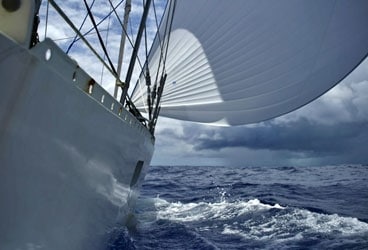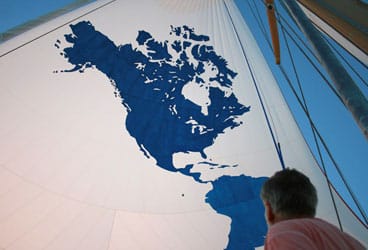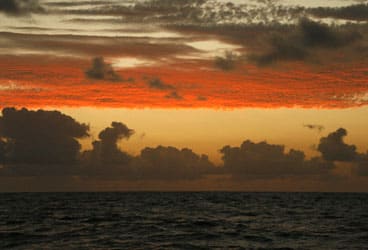
doldrums Herb 368
The last time we sailed into the doldrums, we were heading south, toward Cape Horn. This time, we’re bound north, back to the port of Seattle, where our travels began last May. On this voyage Around the Americas (www.aroundtheamericas.org), we admit to having spent significant portions of the journey in a rather confused state. On March 21, we crossed 2 degrees south, precisely 120 nautical miles south of the equator. Technically, at our location aboard the 64-foot cutter Ocean Watch, it was the first day of autumn. But less than a day’s sail away, it was the beginning of spring. So yes, confusion reigned.

Herb McCormick| |Skipper Mark Schrader checks the set of Ocean Watch‘s big asymmetric kite.|
Not only were we stuck between seasons, here in the doldrums, also known as the Intertropical Convergence Zone; we were also sandwiched between the bands of southeast trade winds that exist on either side of the equator, at least theoretically. But that was another confusing matter. For the waters we’ve just negotiated, the pilot charts-those indispensable month-by-month seasonal averages for winds, currents, and so on-report that in March off the coasts of Peru and Ecuador, we should be enjoying Force 4 easterly breezes-what the Beaufort scale describes as “moderate winds” of 11 to 16 knots-at least 60 percent of the time.
But the trades in this part of the Pacific have, most assuredly, totally disappeared.
Well, that’s not completely true. In the roughly 1,000 miles that we covered after setting forth from Lima, Peru, in the middle of March, we did enjoy a pleasant 12-knot southeaster . . . for exactly six hours. We took advantage of the nice weather to hoist our big asymmetric spinnaker, emblazoned with a rendering of North America, Central America, and South America, but it was a short-lived exercise. Other than that, with the exception of a couple of equally brief periods, it’s a good thing we topped up the diesel tanks in Lima, for the engine’s been turning over the rest of the time.

Herb McCormick| |The sunsets in the doldrums are dramatic and memorable.|
There’s a reason for all this, and we’d known of it before we set out from Peru. The waters off the northwest coast of South America are experiencing a strong El Niño event this year, a semi-regular occurrence that happens about every five years. The ramifications on global weather patterns can be significant during a powerful El Niño, but we’re experiencing the local effects: the absence of trade winds along the equator, weaker currents, and warmer ocean temperatures. The pilot charts say that the seawater at our position should average 24 C this month; a quick glance at the seawater thermometer aboard Ocean Watch today reads almost 30 C.
What haven’t changed in the months since we last crossed the equator are the familiar dramatic skies and sunsets; the heavy air, laden with humidity; and the endless squalls and cells that dot both the horizon and the radar screen. Yup, we’re back in the doldrums.
The good thing is, before we know it, autumn will be over and we’ll again enjoy the fine days of spring. It happened fast this year. We never saw a single leaf fall.








